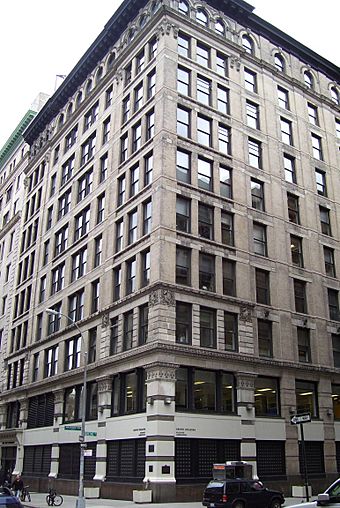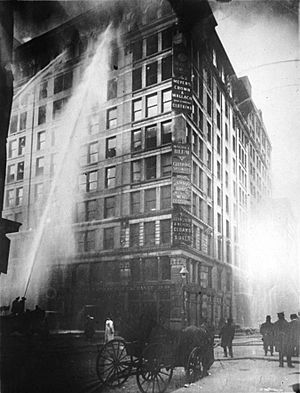Brown Building (Manhattan) facts for kids
|
Triangle Shirtwaist Factory
|
|

(2011)
|
|
| Location | 23–29 Washington Pl, Manhattan, New York City |
|---|---|
| Built | 1900–01 |
| Architect | John Woolley |
| Architectural style | Neo-Renaissance |
| NRHP reference No. | 91002050 |
Quick facts for kids Significant dates |
|
| Added to NRHP | July 17, 1991 |
The Brown Building is a ten-story building in New York City. It is part of the New York University (NYU) campus. You can find it at 23–29 Washington Place in the Greenwich Village area of Manhattan.
This building is famous for a sad event. On March 25, 1911, a terrible fire happened here. It was at the Triangle Shirtwaist Factory, which was inside the building. The fire tragically killed 146 people.
The Brown Building is an important historical site. It was added to the National Register of Historic Places in 1991. It was also named a National Historic Landmark that same year. In 2003, it became a New York City landmark.
Contents
History of the Brown Building
The building was built between 1900 and 1901. It was designed by an architect named John Woolley. He used a style called neo-Renaissance. When it first opened, it was called the Asch Building. It was named after its owner, Joseph J. Asch.
The Asch Building was known for its "fireproof" rooms. This attracted many clothing makers. One of these was the Triangle Shirtwaist Factory. This factory became the site of the tragic fire in 1911.
Workers at the Factory
Most of the workers at the Triangle Shirtwaist Factory were young immigrant women. They had come to the United States hoping for a better life. However, they often worked in very poor conditions. They were also paid very little for their hard work.
The Triangle Shirtwaist Factory took up the top three floors of the building. It was owned by two Russian immigrants, Max Blanck and Isaac Harris.

Factory Conditions Before the Fire
Even though the workers had jobs, their workplace was not safe. The rooms were very crowded. There were not enough working bathrooms. Also, there was no fresh air, so it could be very hot or very cold.
The building did not follow many safety rules. The upper floors were full of things that could easily catch fire. Clothes hung from lines above the workers. Sewing machines were packed closely together. There were also piles of fabric and cloth scraps on the floor. All these things helped the fire spread very quickly.
The building had only one fire escape. It was not strong enough for many people. There were no sprinklers to put out fires. Also, there was no limit on how many people could be on one floor. The staircases were dark and did not have flat resting areas.
The Day of the Fire
A survivor said the fire started from a bin. This bin was under a table where many layers of fabric were stacked. Fire quickly spread from the bin. It lit up tissue paper hanging from the ceiling. Then, the burning paper floated around, starting more fires.
Many people died during the fire. Some died from breathing in smoke. Others were burned by the flames. Many workers jumped from the windows to escape. The inside stairs were blocked. The elevators stopped working because of the heat.
Workers crowded at the stairway entrance. The stairs were too dark to see. In the panic, many people were crushed. This happened as they tried to get through locked doors. The owners and their family used an elevator to escape. They asked the operator to send it back up. But by then, the fire was too big. It was on the eighth floor and spreading fast. This forced more workers to jump from windows or into the elevator shaft.
Some people tried to use the fire escape. But it eventually broke and collapsed. Even before it collapsed, the ladder did not reach the ground. This meant people could not get down safely.
After the Fire
The New York City Fire Department did not have tall enough ladders. Their ladders could only reach the sixth floor. This was two floors below where the fire was burning.
The factory owners, Max Blanck and Isaac Harris, faced many lawsuits. These were from the families of the victims. Because of this fire, many new safety rules were created. These rules included:
- Mandatory fire drills
- Regular fire inspections
- Working fire hoses and sprinklers
- Clear exit signs and fire alarms
- Doors that opened in the direction of escape
- Rules about the size of stairways
The fire also helped the International Ladies' Garment Workers' Union grow. This union worked to improve factory safety. The building itself survived the fire and was repaired. Today, three plaques on the building remember those who died.
In 1916, NYU started using the eighth floor for a library and classrooms. Later, in 1929, a man named Frederick Brown bought the building. He then gave it to NYU. That's when it was renamed the Brown Building. In 2002, it became part of the Silver Center for Arts and Science at NYU.
See also
 In Spanish: Edificio Brown (Manhattan) para niños
In Spanish: Edificio Brown (Manhattan) para niños




